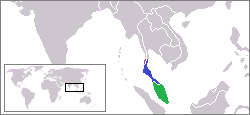Description
Vegetative characteristics
Barclaya rugosa is an aquatic plant with densely villous, 2–8 cm long, and 1–2 cm wide rhizomes. The rugose, cordate, bright green, petiolate, leaves are 8–17 cm long, and 8–16 cm wide. The green petioles are 5–15 cm long. [2]
Generative characteristics
The 5-6 cm wide diurnal flowers are attached to 10-15 cm long peduncles. The flowers have 40–50 anthers. The gynoecium consists of 9 carpels. The globose, 2 cm wide fruit bears ellipsoid, spiny, 2 mm long seeds. The floral fragrance has been characterised as pungent, fermenting, and as smelling of rotten meat. [2]
Cytology
The diploid chromosome count is 2n= 36. [2]
This page is based on this
Wikipedia article Text is available under the
CC BY-SA 4.0 license; additional terms may apply.
Images, videos and audio are available under their respective licenses.
